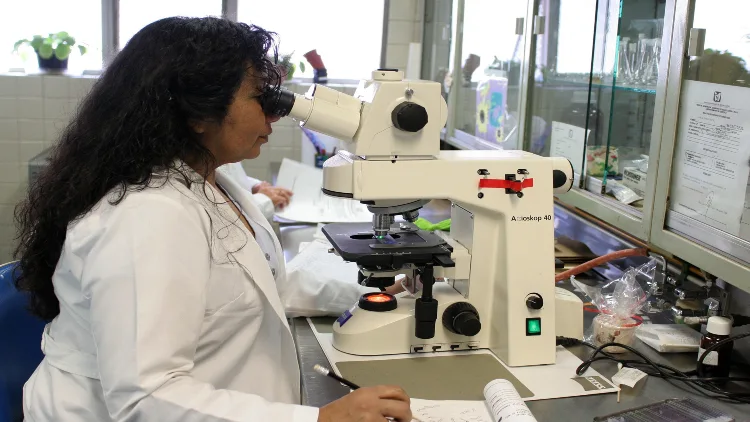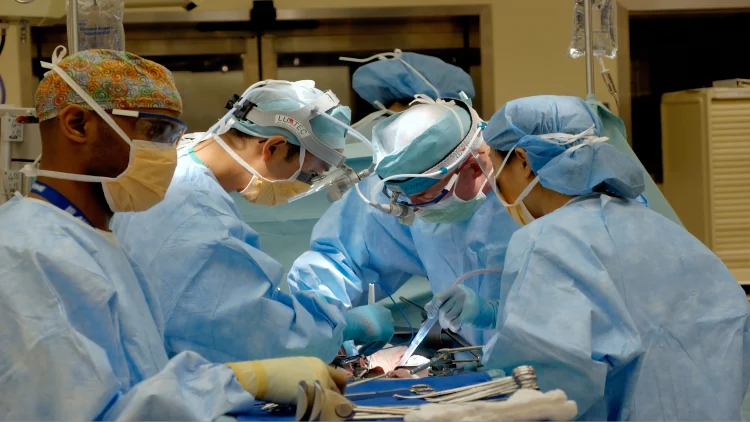
As the obesity epidemic persists in the United States and awareness of Cushing’s disease grows, many people may ponder whether their symptoms are indicative of Cushing’s disease or simply due to being overweight.1
Symptoms of Crushing’s disease oftentimes include weight gain and if you experience any of the symptoms below or have a cause for concern, it’s crucial to seek a medical evaluation rather than self diagnosing. Overall, Crushing’s is fairly rare and jumping to conclusions can cause undue stress and worry.
With that being said, continue reading to learn more about how obesity vs Crushing’s compares, factors that contribute to Crushing’s and who’s at risk, how it’s diagnosed, and since weight loss solutions differ between diagnosis, weight loss solutions for those with and without Crushing’s syndrome.
Understanding Cushing’s Disease & Cushing’s Syndrome
The fluctuation of cortisol levels in the body plays a significant role in causing a disease like Cushing’s. Cortisol is known as the stress hormone and helps the body automatically respond appropriately to stressors, both internal and external, which is known as a fight or flight response.2
Quick releases of cortisol are crucial for reacting to dangerous situations, but having high levels of cortisol frequently can lead to a plethora of health issues like diabetes, heart disease, weight gain, high blood pressure, insomnia, and irregular mood.3
Further, increases in hormone levels of cortisol also causes Cushing’s disease as tumors form inside the pituitary gland, resulting in excessive release of the cortisol-producing hormone adrenocorticotropic hormone.4 This disease is part of a larger hormonal disorder called Cushing’s syndrome, which is caused by long-term exposure of excessive cortisol.
As far as what causes the disease, Cushing’s is typically not passed down genetically but can occur while taking prescription drugs that increase cortisol levels, such as treating an inflammatory disease with synthetic hormone medicine.5 Additionally, Cushing’s can be brought on simply by being under too much stress for long periods of time, which can result in the growth of tumors.
Exhaustive List of Cushing’s Syndrome Symptoms
While there are plenty of distinctive symptoms to tell whether someone truly has Cushing’s, some people may get no symptoms at all. This makes it extremely hard to detect since most healthcare providers look for those symptoms before going on to screen patients for this rare disease.

Source: Alexander Grey via Pixabay6
A full list of Cushing’s symptoms ranges from distinctive outward appearance to internal physical changes and even mental handicaps.7
A full list of symptoms include:
- Excess fat around and above the waist, called “truncal obesity”
- Thin arms and legs
- Round, moon face
- Acne
- Buffalo hump fat pocket between shoulders
- Supraclavicular fat pad around the neck
- Osteoporosis and bone fractures
- Skin infections and ulcers
- Red and purple striae or stretch marks
- Skin that bruises easily and doesn’t heal quickly
- Changes in mood or depression and anxiety
- Feeling extremely tired
- Increase thirst and urination
- High blood pressure
- High cholesterol
- Muscle loss
- Type 2 diabetes
- Heart attack and stroke
- Headaches
- Trouble concentrating and remembering information
- Stunted growth despite obesity in children
- Excessive hair growth in women
- Irregular or no menstruation in women
- Difficulty becoming pregnant in women
- Low sex drive and infertility in men
- Erectile dysfunction in men
Who Is Most at Risk for Cushing’s?
Again, people who also frequently take cortisol-like medicine such as glucocorticoids are also at high risk for developing Cushing’s. While less common, cases have been seen where children have been affected as well.
Even in its rare occurrence of affecting roughly 40-70 people per million, Cushing’s syndrome tends to be more prevalent in women by almost three times the amount and typically is found between the ages of 30-50.8 Studies have shown that women are at higher risk for experiencing stress because of their bodily makeup and are even more likely to experience depression and anxiety from stress.9
Regular exercise plays a key role in reducing mental stress by producing mood-elevating chemicals called endorphins.10 This makes it crucial for women especially to combat life stressors by incorporating an exercise routine like a beginner guide to strength training to keep cortisol levels controlled and prevent Cushing’s from happening.
Distinguishing Between Obesity & Cushing’s Syndrome
Obesity and significant weight gain have been prominent concerns in the United States over the past two decades, leading many individuals to contemplate whether their symptoms could be attributed to Cushing’s disease or solely to being overweight. The CDC reported a drastic increase in obesity prevalence, going from just 30.5% of the population between the years of 1999 and 2000 and shooting up to 41.9% between the years of 2017 and March 2020 — data accounted for stopping just before the pandemic.11
The concern for whether someone battling obesity might also suffer from Cushing’s is completely valid, but luckily, the disease and syndrome come with very distinct symptoms. Not to mention with a diagnosis being very rare, most people will not be affected by the specific negative aspects that come with having Cushing’s.

Source: Towfiqu barbhuiya via Unsplash12
For example, an individual who is overweight but doesn’t have Cushing’s might seek information on rapid weight loss in 2 weeks, and may achieve success through a diet and exercise regimen, whereas those with Cushing’s may find it more challenging.
Weight gain from Cushing’s occurs in specific places, such as the upper body. Someone with Cushing’s may appear very top-heavy, having thin legs and arms with a protruding midsection and fat around the back of the neck, which is sometimes referred to as Cushing’s neck.
Even more distinctive, the skin may easily bruise and appear discolored with red and purple colored stretch marks called striae.13
Consequently from weight gain, moon face symptoms are other signs that someone suffers from Cushing’s, which gives someone the appearance of a round and red-colored face, along with the distinctive appearance of a “buffalo hump” fat deposition between the shoulders.14 Women with Cushing’s primarily have abnormal amounts of hair growth on the face as well as the entire body, while men typically find themselves with decreased fertility and sex drive.15
Getting Diagnosed for Cushing’s Disease
Even with numerous symptoms present, doctors may struggle to diagnose Cushing’s disease due to overlap with symptoms of other health conditions. Without the most distinctive symptoms, patients may find themselves questioning whether they have Cushing’s or if their symptoms are simply due to being overweight.

Source: Ernesto Eslava via Pixabay16
When approaching a crossroads like this one, doctors will probe further into a patient’s medical history, conduct a physical exam, and confirm a diagnosis with several lab tests.
Types of First-Line Screening Tests
In the first set of tests, doctors will want to check the patient’s cortisol levels through one of three tests: a urine cortisol test, a late-night salivary cortisol test, or a dexamethasone suppression test.17 The provider may then choose to conduct a second of these tests if negative results come back the first time.
In the first test, the patient will be asked to collect their urine during a 24-hour period before it is tested. If the cortisol levels come back higher than normal, this is usually a good indicator that Cushing’s syndrome is present.
For the late-night test, a sample of saliva is collected during the late evening time since cortisol levels usually drop when someone falls asleep. For someone with Cushing’s though, their cortisol levels will not drop.
In the last test, the patient is given a low dose of dexamethasone, which is a cortisol suppression drug or a type of glucocorticoid, in the late evening. The next morning, a doctor will test the blood to see if cortisol levels dropped appropriately.
If the levels haven’t dropped, this usually indicates a case of Cushing’s syndrome.
A follow-up test to these three is the dexamethasone-suppressed corticotropin-releasing hormone or Dex-CRH. When a patient shows high levels of cortisol in the first round of tests, this next step will determine whether those levels are caused by Cushing’s or a type of pseudo-Cushing’s, which comes with similar symptoms.
Once Cushing’s syndrome has been diagnosed, the healthcare provider will conduct either a blood test or imaging test to determine the root cause, which will impact recommended treatment. Some tests may not be fully administered properly if the patient is pregnant, suffers from epilepsy or renal failure, or if they display cyclic Cushing’s syndrome where their cortisol levels fluctuate from normal to high.
Weight Loss & Cushing’s Syndrome
Addressing weight gain caused by Cushing’s syndrome hinges on identifying its specific cause, as each requires a distinct approach. Merely undertaking a 30-day weight loss challenge is unlikely to yield results for individuals grappling with Cushing’s.

The transformation of a woman who underwent treatment for Cushing’s syndrome. From bloated and tired to healthy and vibrant, she fought a tough battle and emerged victorious. Source: Noura Costany on YouTube18
Why Diet & Exercise Alone May Not Work
People who once questioned whether they had Cushing’s syndrome or were struggling with weight gain might have experimented with various popular diets without success. They might have also pondered the issue of “ketosis without weight loss” following a diagnosis of Cushing’s, after finding their ketogenic diet ineffective. That’s because diet and exercise alone cannot fix the bodily deficiencies keeping cortisol levels high in someone with Cushing’s syndrome.
Moreover, individuals seeking ways to achieve their ideal physique should understand that this won’t alleviate the characteristic “moon face” caused by Cushing’s disease until the underlying issue is resolved.
Surgical Procedures To Treat Cushing’s
For a patient with Cushing’s whose root cause stems from tumors, there are several treatment methods that can be taken to cure the syndrome and lose weight. The main two categories of tumors include pituitary and adrenal tumors.19
For pituitary tumors, options include surgery, radiation therapy, chemotherapy, and drug therapy. An incision during surgery may occur under the lip or nose most commonly, and if surgery fails to remove all the tumor cells, radiation therapy can be used to kill them with X-rays.

Source: National Cancer Institute via Unsplash20
Chemotherapy does a similar action but is taken by mouth or injected, and drug therapy can be used at the end of everything to correct hormone imbalances.
For adrenal or any other tumors, surgery is used to remove the gland and often a drug is prescribed to help produce cortisol in place of the missing gland until the other catches up. If both glands are removed, a patient will be on medication for the rest of their life in order to completely replace their function.
Cortisol Regulating Medication
Sometimes tumors cannot be removed at all, which is when a doctor may prescribe medicine to block cortisol release instead. If someone with Cushing’s syndrome traces their root cause back to a certain medication rather than development of a tumor, a doctor may swap this medication out for a different one or slowly decrease its use.
Weight Loss Solutions for Those Who Don’t Have Cushing’s Syndrome
Without having Cushing’s syndrome or disease, weight loss can occur for many reasons. Overeating tends to be one of the biggest factors for Americans, especially with big portion sizes and having food delivery available through just the click of a button.
Not being active enough is also a growing factor as more Americans work longer hours and have distractions like choosing to binge Netflix over getting outside or going to the gym.

Source: Anastase Maragos from Unsplash21
Additionally, many people do battle other diseases or health complications that can lead to weight gain. Anything from a simple temporary injury to a long-term sickness like hypothyroidism can cause someone to face weight gain.
Anyone facing a health issue should always refer to a doctor for diagnosis and medication that can help maintain symptoms.
Luckily, those who aren’t diagnosed with Cushing’s syndrome, or other illnesses, have several options for healthy and natural weight loss solutions that don’t involve surgery or medication. While weight loss affirmations can positively contribute to a successful weight loss routine, they should not be solely relied on.
Proper diet and exercise are the most effective ways to lose weight safely.
Establishing a solid workout routine is key to losing weight, and one of the fastest ways involves combining both cardio and resistance training. Resistance training — such as powerlifting programs for beginners — has been proven to increase metabolism and reduce weight from fat.22
Given that muscle weighs more than fat, the scale doesn’t hold much significance, as a lifter might become leaner even as their weight increases.
While cardio has a lot of great benefits, such as fat loss, doing it alone without any strength training reduces muscle; however, cycling has been shown to be a better cardio option than running because it prevents the loss of muscle.23 Selecting a workout regimen that one finds enjoyable and can consistently maintain is crucial for effective weight loss. This is why opting for Peloton for overweight beginners proves to be an excellent choice, offering enjoyable classes and supportive coaches.
People struggling with obesity or being overweight should remember that it will not exactly be easy nor is it a process that should be rushed; rather the most effective way to view weight loss is maintaining a consistent, healthy, well-rounded lifestyle. So before giving up on weight loss, be sure to establish success habits such as:
- Starting the day off with a healthy breakfast
- Getting to bed earlier
- Keeping snack wholesome and healthy, such as nuts and fruit
- Keeping self-talk positive and motivating, even during slip-ups
- Finding an alternative stress outlet instead of eating, such as working out
Individuals questioning whether they have Cushing’s syndrome or are experiencing weight gain should prioritize examining the specific symptoms and seeking an accurate diagnosis from a healthcare professional. This diagnosis will guide the most suitable treatment options, if necessary, and ensure safe weight loss methods.
Frequently Asked Questions
How Much Weight Gain Can Cushing’s Cause?
The extent of weight gain in individuals with Cushing’s syndrome can vary widely. The key indicators to watch for include rapid weight gain in the face, leading to the characteristic “Cushing’s face,” as well as the distinct trunk obesity associated with Cushing’s syndrome, while the arms and legs may remain relatively thin.
Can Someone Have Cushing’s Without Knowing?
It is possible to have Cushing’s without knowing because not everyone shows symptoms. It also helps to know which specific symptoms are solely related to this syndrome and not another illness, such as a buffalo hump between the shoulders or excessive facial hair in women.
Which Diseases Resemble Cushing's Syndrome?
Several illnesses can imitate Cushing’s syndrome and its symptoms. Cushing’s has been recognized as a prototype of metabolic syndrome since elevated cortisol levels can result in carbohydrate irregularities and increased waistline weight.
Similarly, Cushing’s also shows the same signs as polycystic ovary syndrome, where women develop the same high levels of male hormones and have irregular periods.
Could Increased Hunger Indicate Cushing’s Syndrome, or Is It Simply Due to Weight Gain?
Excessive cortisol levels, which is seen in Cushing’s, can stimulate the appetite and cause overeating. This makes it difficult to tell apart someone who has Cushing’s and someone who does not, and therefore, should not be an indicator of whether someone has the syndrome.
References
1Priyanka N Jain. “I Never Had PCOS… It Was Cushing’s Disease / Cushing’s Syndrome.” YouTube, 16 April 2019, Accessed 6 April 2023. <https://www.youtube.com/watch?v=Pnk_1x1G44A>
2Thau, L., Gandhi, J., & Sharma, S. (2022, August 29). Physiology, Cortisol. Retrieved February 2023, from National Library of Medicine: <https://www.ncbi.nlm.nih.gov/books/NBK538239/>
3Hannibal, K., & Bishop, M. (2014, July 17). Chronic Stress, Cortisol Dysfunction, and Pain: A Psychoneuroendocrine Rationale for Stress Management in Pain Rehabilitation . Retrieved February 2023, from National Library of Medicine: <https://www.ncbi.nlm.nih.gov/pmc/articles/PMC4263906/>
4MedlinePlus. (2012, June 1). Cushing disease. Retrieved February 2023, from MedlinePlus: <https://medlineplus.gov/genetics/condition/cushing-disease/#causes>
5MedlinePlus. (2016, October 5). Cushing’s syndrome. Retrieved February 2023, from MedlinePlus: <https://medlineplus.gov/cushingssyndrome.html>
6Grey, Alexander. “Free Image on Pixabay – Struggle, Acne, Self Love, Skin.” Pixabay, 13 November 2018, Accessed 6 April 2023. <https://pixabay.com/photos/struggle-acne-self-love-skin-face-3805349/>
7Office of Communications. (2022, May 4). What are the symptoms of Cushing syndrome? Retrieved February 2023, from National Institute of Child Health and Human Development: <https://www.nichd.nih.gov/health/topics/cushing/conditioninfo/symptoms>
8National Institution of Diabetes and Digestive and Kidney Diseases. (2018, May). Cushing’s syndrome. Retrieved February 2023, from National Institution of Diabetes and Digestive and Kidney Diseases: <https://www.niddk.nih.gov/health-information/endocrine-diseases/cushings-syndrome>
9Office on Women’s Health. (2021, February 17). Stress and your health. Retrieved February 2023, from Office on Women’s Health: <https://www.womenshealth.gov/mental-health/good-mental-health/stress-and-your-health>
10Harvard Health Publishing. (2020, July 7). Exercising to relax. Retrieved February 2023, from Harvard Health Publishing: <https://www.health.harvard.edu/staying-healthy/exercising-to-relax>
11Centers for Disease Control and Prevention. (2022, May 17). Adult Obesity Facts. Retrieved February 2023, from Centers for Disease Control and Prevention: <https://www.cdc.gov/obesity/data/adult.html>
12Towfiqu barbhuiya. “a man holding his stomach with his hands photo – Free Person Image on Unsplash.” Unsplash, 17 October 2021, Accessed 6 April 2023. <https://unsplash.com/photos/J6g_szOtMF4>
13Stratakis, C. (2016, September). Skin manifestations of Cushing’s syndrome. Retrieved February 2023, from National Library of Medicine: <https://pubmed.ncbi.nlm.nih.gov/27943005/>
14Clutter, W. (2011, March). Screening for Cushing’s Syndrome in an Era of Epidemic Obesity . Retrieved February 2023, from National Library of Medicine: <https://www.ncbi.nlm.nih.gov/pmc/articles/PMC6189156/>
15Neuroendocrine & Pituitary Tumor Clinical Center. (n.d.). Cushing’s Disease / Cushing’s Syndrome. Retrieved February 2023, from Neuroendocrine & Pituitary Tumor Clinical Center: <https://pituitary.mgh.harvard.edu/CushingsSyndrome.htm>
16Eslava, Ernesto. “Laboratory Care Health – Free photo on Pixabay.” Pixabay, 6 October 2017, Accessed 6 April 2023. <https://pixabay.com/photos/laboratory-care-health-medical-2821207/>
17Office of Communications. (2019, May 9). How do healthcare providers diagnose Cushing syndrome? . Retrieved February 2023, from National Institute of Child Health and Human Development: <https://www.nichd.nih.gov/health/topics/cushing/conditioninfo/diagnosis>
18Noura Costany. “Cushings Disease – My Story.” YouTube, 31 March 2020, Accessed 1 April 2023. <https://www.youtube.com/watch?v=stucJYSWhlg>
19Office of Communications. (2019, May 9). What are the treatments for Cushing syndrome? Retrieved February 2023, from National Institute of Child Health and Human Development: <https://www.nichd.nih.gov/health/topics/cushing/conditioninfo/treatments>
20National Cancer Institute. “man in white dress shirt wearing white goggles photo – Free Operating theatre Image on Unsplash.” Unsplash, 22 January 2020, Accessed 6 April 2023. <https://unsplash.com/photos/KrsoedfRAf4>
21Anastase Maragos. “topless man in black shorts carrying black dumbbell photo – Free Fitness Image on Unsplash.” Unsplash, 6 February 2020, Accessed 6 April 2023. <https://unsplash.com/photos/7kEpUPB8vNk>
22Westcott, W. (2012, July). Resistance training is medicine: effects of strength training on health . Retrieved February 2023, from National Library of Medicine: <https://pubmed.ncbi.nlm.nih.gov/22777332/#:~:text=Ten%20weeks%20of%20resistance%20training%20may%20increase%20lean,walking%20speed%2C%20functional%20independence%2C%20cognitive%20abilities%2C%20and%20self-esteem>
23Williams, J. (2021, June 23). Does cardio burn muscle? What you need to know. Retrieved February 2023, from Lionel University: <https://blog.lionel.edu/does-cardio-burn-muscle>